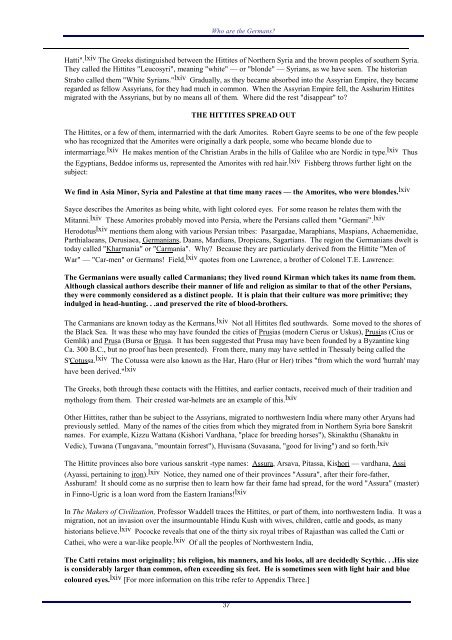WHO ARE THE GERMANS - Churches of God Cyber Auxiliary
WHO ARE THE GERMANS - Churches of God Cyber Auxiliary
WHO ARE THE GERMANS - Churches of God Cyber Auxiliary
Create successful ePaper yourself
Turn your PDF publications into a flip-book with our unique Google optimized e-Paper software.
Who are the Germans?<br />
Hatti". lxiv The Greeks distinguished between the Hittites <strong>of</strong> Northern Syria and the brown peoples <strong>of</strong> southern Syria.<br />
They called the Hittites "Leucosyri", meaning "white" — or "blonde" — Syrians, as we have seen. The historian<br />
Strabo called them "White Syrians." lxiv Gradually, as they became absorbed into the Assyrian Empire, they became<br />
regarded as fellow Assyrians, for they had much in common. When the Assyrian Empire fell, the Asshurim Hittites<br />
migrated with the Assyrians, but by no means all <strong>of</strong> them. Where did the rest "disappear" to?<br />
<strong>THE</strong> HITTITES SPREAD OUT<br />
The Hittites, or a few <strong>of</strong> them, intermarried with the dark Amorites. Robert Gayre seems to be one <strong>of</strong> the few people<br />
who has recognized that the Amorites were originally a dark people, some who became blonde due to<br />
intermarriage. lxiv He makes mention <strong>of</strong> the Christian Arabs in the hills <strong>of</strong> Galilee who are Nordic in type. lxiv Thus<br />
the Egyptians, Beddoe informs us, represented the Amorites with red hair. lxiv Fishberg throws further light on the<br />
subject:<br />
We find in Asia Minor, Syria and Palestine at that time many races — the Amorites, who were blondes. lxiv<br />
Sayce describes the Amorites as being white, with light colored eyes. For some reason he relates them with the<br />
Mitanni. lxiv These Amorites probably moved into Persia, where the Persians called them "Germani”. lxiv<br />
Herodotuslxiv mentions them along with various Persian tribes: Pasargadae, Maraphians, Maspians, Achaemenidae,<br />
Parthialaeans, Derusiaea, Germanians, Daans, Mardians, Dropicans, Sagartians. The region the Germanians dwelt is<br />
today called "Kharmania" or "Carmania". Why? Because they are particularly derived from the Hittite "Men <strong>of</strong><br />
War" — "Car-men" or Germans! Field, lxiv quotes from one Lawrence, a brother <strong>of</strong> Colonel T.E. Lawrence:<br />
The Germanians were usually called Carmanians; they lived round Kirman which takes its name from them.<br />
Although classical authors describe their manner <strong>of</strong> life and religion as similar to that <strong>of</strong> the other Persians,<br />
they were commonly considered as a distinct people. It is plain that their culture was more primitive; they<br />
indulged in head-hunting. . .and preserved the rite <strong>of</strong> blood-brothers.<br />
The Carmanians are known today as the Kermans. lxiv Not all Hittites fled southwards. Some moved to the shores <strong>of</strong><br />
the Black Sea. It was these who may have founded the cities <strong>of</strong> Prusias (modern Cierus or Uskus), Prusias (Cius or<br />
Gemlik) and Prusa (Bursa or Brusa. It has been suggested that Prusa may have been founded by a Byzantine king<br />
Ca. 300 B.C., but no pro<strong>of</strong> has been presented). From there, many may have settled in Thessaly being called the<br />
S'Cotussa. lxiv The Cotussa were also known as the Har, Haro (Hur or Her) tribes "from which the word 'hurrah' may<br />
have been derived." lxiv<br />
The Greeks, both through these contacts with the Hittites, and earlier contacts, received much <strong>of</strong> their tradition and<br />
mythology from them. Their crested war-helmets are an example <strong>of</strong> this. lxiv<br />
Other Hittites, rather than be subject to the Assyrians, migrated to northwestern India where many other Aryans had<br />
previously settled. Many <strong>of</strong> the names <strong>of</strong> the cities from which they migrated from in Northern Syria bore Sanskrit<br />
names. For example, Kizzu Wattana (Kishori Vardhana, "place for breeding horses"), Skinakthu (Shanaktu in<br />
Vedic), Tuwana (Tungavana, "mountain forrest"), Huvisana (Suvasana, "good for living") and so forth. lxiv<br />
The Hittite provinces also bore various sanskrit -type names: Assura, Arsava, Pitassa, Kishori — vardhana, Assi<br />
(Ayassi, pertaining to iron). lxiv Notice, they named one <strong>of</strong> their provinces "Assura", after their fore-father,<br />
Asshuram! It should come as no surprise then to learn how far their fame had spread, for the word "Assura" (master)<br />
in Finno-Ugric is a loan word from the Eastern Iranians! lxiv<br />
In The Makers <strong>of</strong> Civilization, Pr<strong>of</strong>essor Waddell traces the Hittites, or part <strong>of</strong> them, into northwestern India. It was a<br />
migration, not an invasion over the insurmountable Hindu Kush with wives, children, cattle and goods, as many<br />
historians believe. lxiv Pococke reveals that one <strong>of</strong> the thirty six royal tribes <strong>of</strong> Rajasthan was called the Catti or<br />
Cathei, who were a war-like people. lxiv Of all the peoples <strong>of</strong> Northwestern India,<br />
The Catti retains most originality; his religion, his manners, and his looks, all are decidedly Scythic. . .His size<br />
is considerably larger than common, <strong>of</strong>ten exceeding six feet. He is sometimes seen with light hair and blue<br />
coloured eyes. lxiv [For more information on this tribe refer to Appendix Three.]<br />
37


